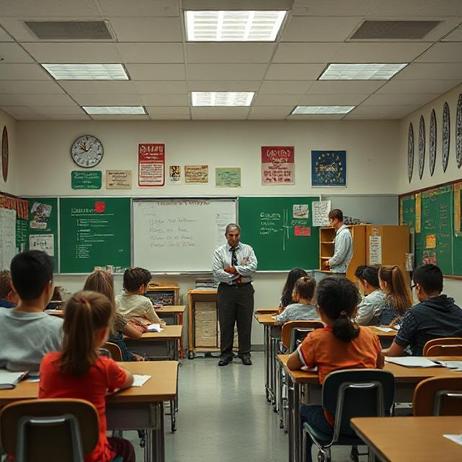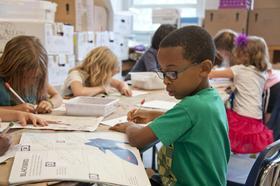How Are U.S. Public Schools Doing in 2025?
As we move through 2025, U.S. public schools face a mix of pressures, opportunities, and evolving expectations. In many places, the aftershocks of the COVID-19 era remain visible in student learning, staffing, and finances. Meanwhile, new forces—like artificial intelligence, shifting enrollment patterns, and political debates over curriculum—are reshaping how parents, educators, and policymakers view public education. This article updates the landscape for 2025, offering insight into fresh data, emerging trends, and ongoing challenges in U.S. public schools.
Enrollment and Demographics: A Changing Landscape
According to the 2025 Condition of Education report, 49.5 million students were enrolled in public elementary and secondary schools in fall 2023—the latest official figure.That number remains below the 50.8 million level recorded before the pandemic, reflecting a longer-term decline in enrollment.Projections by NCES suggest continued modest decline into 2025.
Among key demographic shifts:
The national student-to-teacher ratio in 2025 is estimated at 15:1.
School districts continue to become more diverse in student racial and ethnic composition, though significant gaps remain in representation and resources.
Some states, especially in parts of the Rust Belt, rural South, and inland West, show sharper drops in K–12 enrollment, compounding financial stress for their districts.
Districts in fast-growing regions (Sun Belt, parts of the Southeast) face pressure to expand capacity or rezone amid uneven population growth.
These enrollment dynamics materially affect how districts plan curricula, staffing, and capital spending. As many districts derive funding in part from per-pupil allocations, declining enrollment translates directly into tighter budgets and harder tradeoffs in resources.
Achievement and Learning Outcomes: Mixed Signals National Assessment: A Sobering View
The most watched barometer of student achievement is the National Assessment of Educational Progress (NAEP), also known as “the Nation’s Report Card.”In 2025, scores reveal that many students continue to struggle—and in some cases are regressing—particularly in reading.
In a recent press statement, U.S. Education Secretary McMahon warned that “nearly half of America’s high school seniors are testing at below basic levels in math and reading,” citing “historic lows” across K–12.Other media coverage similarly frames the results as deeply concerning for long-term outcomes.For reading, fourth and eighth graders have seen modest declines: average scores have dropped approximately 2 points since 2022 and as much as 5 points since 2019.Meanwhile, mathematics performance is uneven: small gains occur in some grades and states, but many students still fall short of proficiency benchmarks.
In short: learning gaps, exacerbated during the pandemic, remain stubbornly persistent.
Confidence and Perception Trends
Despite data showing strains in learning, student and parent sentiment shows a surprising uptick. According to the 2025 Walton Family Foundation–Gallup Student Report Card, 71% of students now grade their school an A or B—up from 64% in 2024 and 66% in 2023. Parental ratings also improved: 40% of parents now award an A to their child’s school (vs. 33% in 2024).This optimism may reflect improvements in climate, extracurricular offerings, or more strategic communication by districts. But the perception boost faces tension with objective measures of academic performance—especially in low-income and underserved communities.
Funding, Costs, and Resource Challenges Revenue and Expenditure Realities
Public per-student expenditure in 2023–24 years averaged approximately $16,722. That figure aligns with the more general findings in the NCES Condition of Education for district revenues and spending.At the same time, inflation, rising health care costs, and capital maintenance pressure already strained district budgets.
State and local budgets remain the primary funding sources for public K–12 education, with the federal share hovering around 8–10% nationally.Debates over additional federal stimulus or expansion in Title I, IDEA, or pandemic-recovery aid remain active in Congress.
Staffing and Teacher Supply
Quality instruction depends on strong teacher recruitment and retention—but that has become an acute challenge. In Houston ISD, as one example, roughly one in four teachers in 2025–26 is uncertified. Across many districts, attrition is high, especially among early-career teachers and those in high-stress schools.
At the same time, districts are increasingly offering incentives—higher salaries, housing stipends, loan forgiveness, and hybrid work options—to attract talent. Career pathways, mentorship programs, and alternative certification schemes are more visible now as part of retention strategies.
Yet these strategies must contend with rising pension liabilities, benefit costs, and shrinking per-pupil revenue in many districts.
Program Trends, Innovation, and Policies in 2025 Artificial Intelligence and Learning Tools
Generative AI is no longer a fringe concept: in 2025, many districts are piloting or scaling AI tools designed to support differentiated instruction, tutoring, formative assessment, and administrative tasks.A recent study examined how math and science teachers are adopting GenAI tools, revealing patterns of cautious but growing use in classroom settings.
Districts and educators are balancing promise and risk—ensuring AI complements rather than replaces human guidance, guarding data privacy, training teachers, and mitigating overreliance.
Curriculum Mandates & Controversies
The curriculum wars have intensified in 2025. In February, the U.S. Department of Education launched an “End DEI” portal, allowing the public to file complaints about diversity, equity, and inclusion programs in K–12 schools—reflecting a broader federal push to curtail DEI initiatives.
In some states, legislation mandating adoption of literacy frameworks based on the “science of reading” has gained traction. In New York, for example, by September 2025, all instructional materials and professional development must align with evidence-based reading instruction.Still, many teachers report uneven implementation or blending legacy approaches rather than full adoption.
Meanwhile, not all accountability mechanisms remain intact. In Massachusetts, a 2024 ballot initiative removed the requirement that students pass the state’s MCAS exam to receive a high school diploma—though MCAS remains as a benchmark assessment.
School Choice, Charters, and Competition
As public districts face fiscal and enrollment pressures, school choice and charter expansion remain politically salient and administratively consequential. According to one data source, roughly 80% of K–12 students attended traditional public district schools in 2024, while 7% attended charter schools. In some regions, voucher or tuition tax–credit programs draw students away from traditional public schools.
Private school choice is also gaining attention. Some reports indicate sharp year-over-year growth in private school enrollment options, putting further competitive pressure on public systems.
Districts are responding via enhanced marketing, community engagement, and program diversification (e.g. dual enrollment, STEM focus, arts integration) to retain families.Redistricting and Integration Strategies
Research in 2025 has proposed algorithmic and community-driven frameworks for redrawing school attendance boundaries to reduce segregation, balance resources, and preserve neighborhood ties.Other studies explore merging underutilized schools to promote integration with manageable travel burdens.Such structural changes require community buy-in, political appetite, and careful sensitivity to equity and local sentiment. In many districts, redistricting remains a fraught but potentially powerful lever.
Real-World Example: Texas’ Recent Gains
Texas recently released campus ratings for 2024–25, showing incremental improvements.A total of 757 campuses improved from lower ratings to an A, and 31% of all campuses improved year-over-year.Notably, 43% of high-poverty campuses now earned an A or B—a signal that improvement at scale is possible even in challenging demographics.This suggests that with strategic support, style="line-height:1.38;margin-top:0pt;margin-bottom:0pt;">
Outlook and Key Questions Going Forward
As we move deeper into 2025, several pivotal questions frame the future of public schooling:
Can more districts sustain academic recovery? Many will depend on targeted remediation, early literacy investments, and leveraging AI tools wisely.
Will funding models adapt to shrinking enrollments? Districts may need to rethink staffing, consolidation, and cost-sharing collaborations.
How will political mandate pressure shape curricula? State and federal policies around DEI, reading science, and assessment will drive local adjustments.
Can public schools reclaim trust and relevance amid choice competition? Transparent communication, innovative programming, and community connection will matter.
What role will technology play without exacerbating inequities? Ensuring equitable access and high-quality implementation is paramount.
Public schools in 2025 do not exist in crisis, but many are under strain. For parents, educators, and communities, the path forward lies in data-informed decision making, resource alignment, and a commitment to every student’s opportunity to learn. As the landscape shifts, so too must how we measure success in U.S. public schools.















